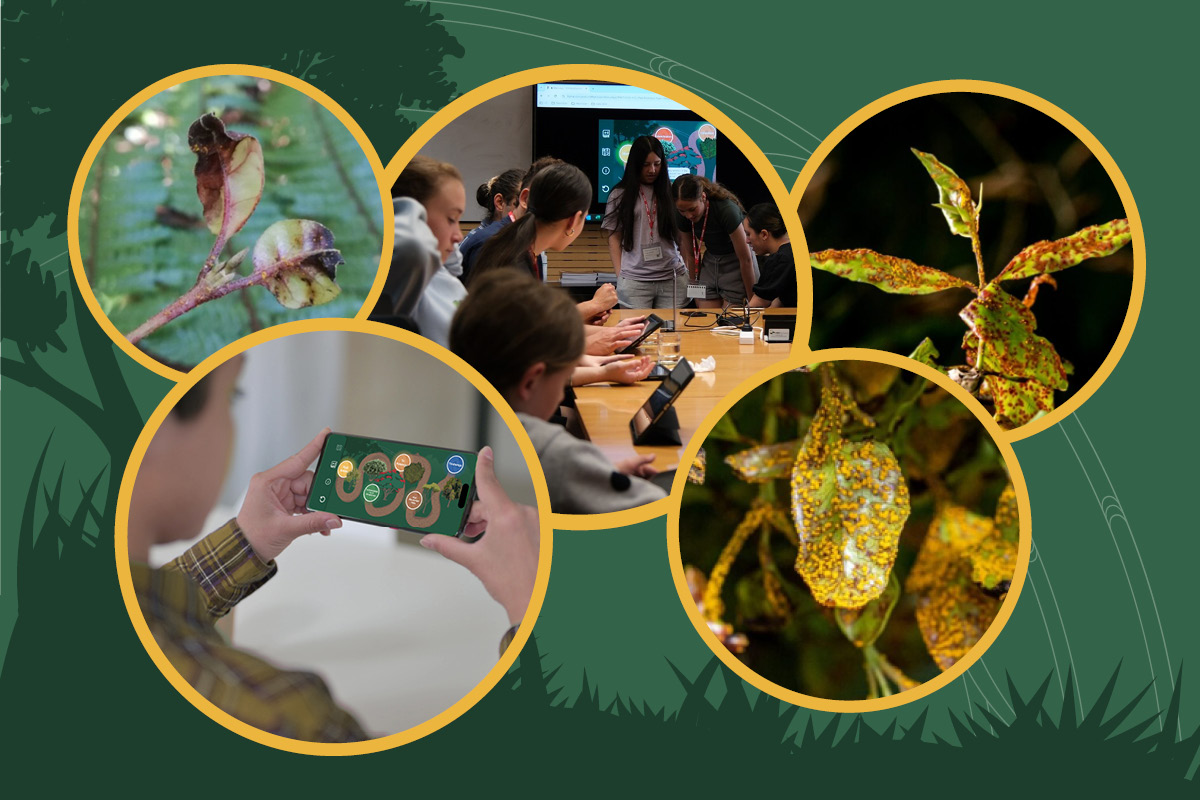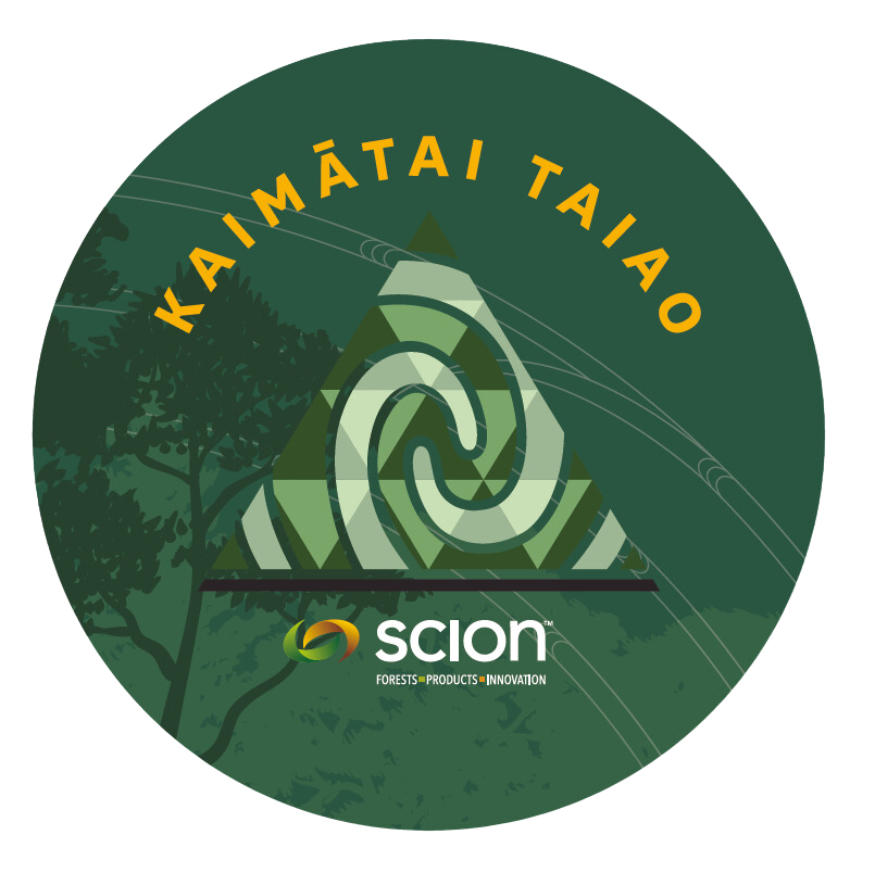E heke e Heka! (English)
Click here to read in Te Reo Māori.
Scion’s Restoration Protection and Mauri o Te Waonui a Tāne science portfolio focuses research on preparing for and responding to climate-enhanced ecological risks in our standing forests, including insects, pathogens, fire, social and Māori-led research for intergenerational prosperity and perpetuity of ngahere for Aotearoa, New Zealand.
E heke e Heka! is a Māori-led project that shares environmental science knowledge about myrtle rust and aims to increase accessibility and awareness for young people and community to be informed on an issue that is impacting myrtle taonga species.
Kaupapa – Background
Myrtle rust is a fungal disease affecting indigenous and exotic species of the Myrtaceae family and presents a significant threat to biodiversity in New Zealand’s ngahere (forests).
Since being detected in New Zealand, scientists and kaitiaki have been researching and monitoring the disease. However, until now there has been an absence of accessible myrtle rust resources targeted to rangatahi (young people) and community, particularly in Te Reo Māori.
The Unlocking Curious Minds fund supported Scion to develop ‘E heke e Heka!’ a new interactive learning app designed to empower rangatahi (young people) with knowledge about myrtle rust. With a focus on accessibility and engagement, the app combines current science information with creative and culturally relevant content, promoting Te Reo Māori and Reo Rua bilingual language options for diverse audiences ages 12 years and above.
It also features ‘Mātaihia Te Heka!’ Augmented Reality innovation app technology that brings the tree (branches) to life and allows the user to explore, search for and identify myrtle rust on different myrtle species.

Te Reo Māori
Myrtle rust currently has no official name or translation in Te Reo Māori. Some transliterations have been utilised in various settings or often, the English term myrtle rust is used in Te Reo Māori settings. This app promotes the use of Te Reo Māori and Reo Rua bilingual language options, and it was therefore appropriate that the project team explore methods for describing and referencing myrtle rust in Te Reo Māori throughout the learning app. This involved wānanga (forum) with science, mātauranga Māori and Te Reo Māori specialists exponents to examine the characteristics of the Myrtaceae species, effects of the fungus and linguistic whakapapa (origins) of flora across Polynesia.
Kahika – connects proto-Oceanic and proto-Polynesian linguistic roots of Myrtaceae species.
Heka – in the context of myrtle rust, is used as a noun, verb and adjective, e.g. fungi, fungal rust, infection.
Heka Kahika – is used to describe myrtle rust in this app.
Whānau Kahika – Is used to describe ‘Myrtaceae’ species in this app.
E heke, e Heka! Title of the app that personifies and signifies the aspiration to minimise myrtle rust.
Mātaihia Te Heka! Augmented reality (AR) app for myrtle rust identification through game-based learning.
In using the augmented reality activity, one student said, “it felt like I was in the ngahere”. Others commented on the app content being interesting, important, and teaching them a lot.
In the myrtle rust virtual learning ngahere, the user journeys through stages, gaining knowledge on different aspects of science related to Myrtaceae – myrtle plants, the origin of myrtle rust, infection, identification, environmental factors, and outlook for the future.
The app steps the user through environmental science content in a digestible way, incorporating digital illustrations and photo reference visuals, interactive elements, games, and augmented reality activities that connects the app user to the knowledge presented.
Te Ao Māori can be considered and incorporated in accordance with the user’s own mātauranga-a-rohe as appropriate to their taiao and local environment.
Akoako – Engagement
Rangatahi fluent in Te Reo Māori, aged 10 to 18 visited Scion to explore and test a prototype of the app and provide feedback. A baseline of myrtle rust understanding was collected at the start and end to see how effective the app is as an interactive learning tool. All rangatahi entered the wānanga with little to no knowledge of myrtle rust or native myrtle species and by the end of the wānanga, all rangatahi had gained an increased awareness about myrtle rust and were able to explain aspects of what they had learnt with detail.
They also provided some feedback that has been incorporated into the final app version.
Kaiako Reo Māori – teachers of Te Reo Māori also provided input and feedback during the app development. This guided ways to consolidate and connect the information to activities and support appropriate transmission of the science knowledge particularly for rangatahi.
This app can be used both as a self-directed learning tool or in a guided learning setting such as Kura or training programmes.
Nga kupu aumihi – Acknowledgements
Ministry of Business, Innovation and Employment (MBIE) Unlocking Curious Minds Fund. Ngā Kura tautoko, Kiwa Digital, Conical Studios, Te Haeata Consultancy Ltd. (Ruakiri and Uenuku Fairhall), Jacob McGregor, Rangatahi focus group, Te Whaeoranga Smallman, Dr. Stuart Fraser, Te Rātā Whakamaru, Kanapu Rangitauira, Hana Aranga, Sera Raroa, Lisa Berndt, Roanne Sutherland, Jasmine Hessell, Maria Zhulanov, Kim Murrell, Claire Stewart, Grant Evans, iNaturalist NZ & New Zealand Plant Conservation Network
Scion Research Team:
Katerina Pihera-Ridge
Dr. Michael Bartlett
Piata Raroa
Taiāwhio Bryers
Sierra De La Croix
Contact: ngahere@scionresearch.com
Download the apps here!
- E heke e Heka! (Apple App Store)
- E heke e Heka! (Google Play)
- Mātaihia te heka (Apple App Store)
